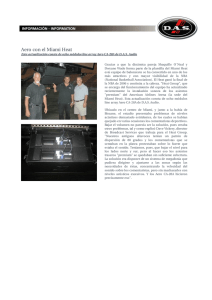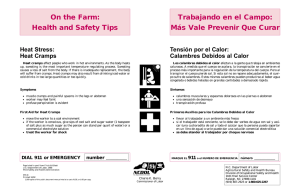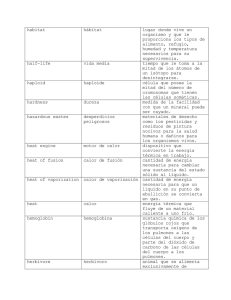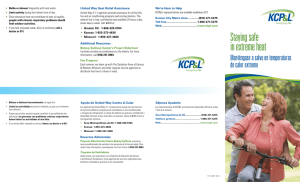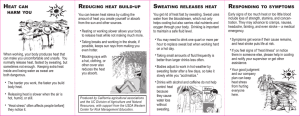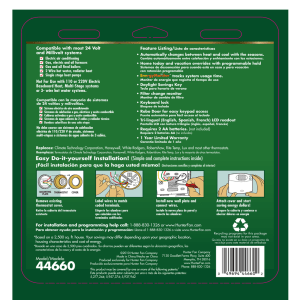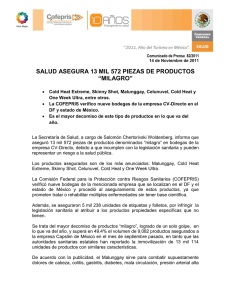SAFETY TOOLBOX TALKS
Anuncio
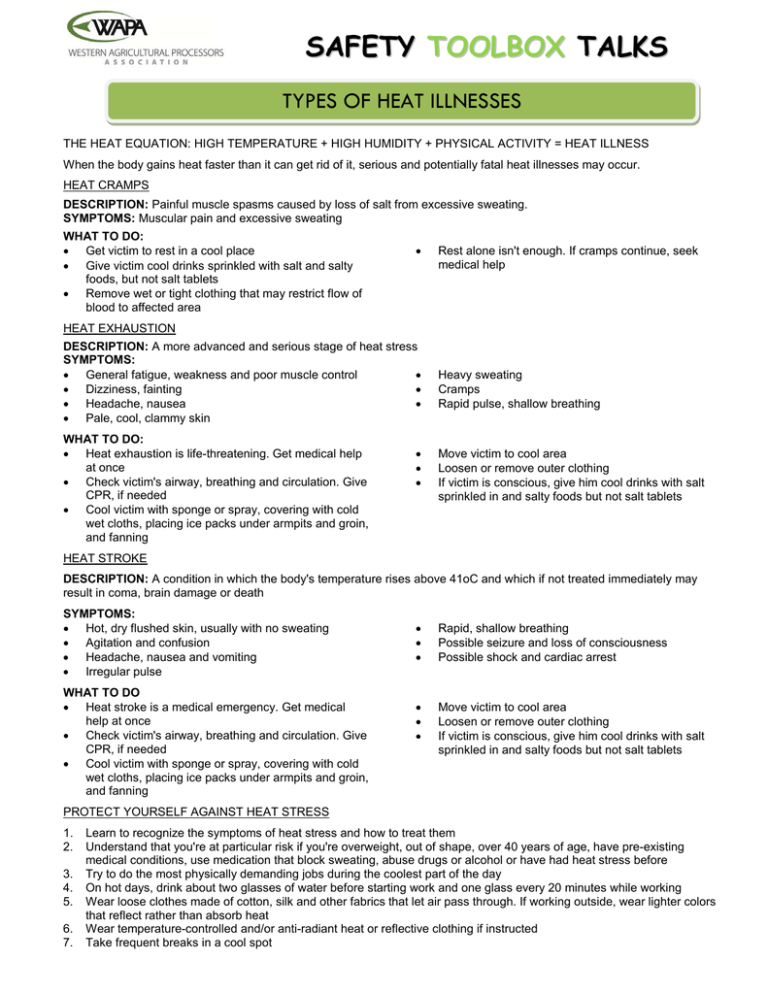
SAFETY TOOLBOX TALKS TYPES OF HEAT ILLNESSES THE HEAT EQUATION: HIGH TEMPERATURE + HIGH HUMIDITY + PHYSICAL ACTIVITY = HEAT ILLNESS When the body gains heat faster than it can get rid of it, serious and potentially fatal heat illnesses may occur. HEAT CRAMPS DESCRIPTION: Painful muscle spasms caused by loss of salt from excessive sweating. SYMPTOMS: Muscular pain and excessive sweating WHAT TO DO: • Get victim to rest in a cool place • Give victim cool drinks sprinkled with salt and salty foods, but not salt tablets • Remove wet or tight clothing that may restrict flow of blood to affected area • Rest alone isn't enough. If cramps continue, seek medical help HEAT EXHAUSTION DESCRIPTION: A more advanced and serious stage of heat stress SYMPTOMS: • General fatigue, weakness and poor muscle control • • Dizziness, fainting • • Headache, nausea • • Pale, cool, clammy skin WHAT TO DO: • Heat exhaustion is life-threatening. Get medical help at once • Check victim's airway, breathing and circulation. Give CPR, if needed • Cool victim with sponge or spray, covering with cold wet cloths, placing ice packs under armpits and groin, and fanning • • • Heavy sweating Cramps Rapid pulse, shallow breathing Move victim to cool area Loosen or remove outer clothing If victim is conscious, give him cool drinks with salt sprinkled in and salty foods but not salt tablets HEAT STROKE DESCRIPTION: A condition in which the body's temperature rises above 41oC and which if not treated immediately may result in coma, brain damage or death SYMPTOMS: • Hot, dry flushed skin, usually with no sweating • Agitation and confusion • Headache, nausea and vomiting • Irregular pulse WHAT TO DO • Heat stroke is a medical emergency. Get medical help at once • Check victim's airway, breathing and circulation. Give CPR, if needed • Cool victim with sponge or spray, covering with cold wet cloths, placing ice packs under armpits and groin, and fanning • • • Rapid, shallow breathing Possible seizure and loss of consciousness Possible shock and cardiac arrest • • • Move victim to cool area Loosen or remove outer clothing If victim is conscious, give him cool drinks with salt sprinkled in and salty foods but not salt tablets PROTECT YOURSELF AGAINST HEAT STRESS 1. 2. 3. 4. 5. 6. 7. Learn to recognize the symptoms of heat stress and how to treat them Understand that you're at particular risk if you're overweight, out of shape, over 40 years of age, have pre-existing medical conditions, use medication that block sweating, abuse drugs or alcohol or have had heat stress before Try to do the most physically demanding jobs during the coolest part of the day On hot days, drink about two glasses of water before starting work and one glass every 20 minutes while working Wear loose clothes made of cotton, silk and other fabrics that let air pass through. If working outside, wear lighter colors that reflect rather than absorb heat Wear temperature-controlled and/or anti-radiant heat or reflective clothing if instructed Take frequent breaks in a cool spot SAFETY TOOLBOX TALKS TIPOS DE ENFERMEDADES DE LA CALOR LA EQUACIÓN DEL CALOR: ALTA TEMPERATURA + ALTA HUMEDAD+ ACTIVIDAD FISICA= ENFERMEDAD POR EL CALOR Cuando el cuerpo absorbe calor más rápido del que pueda soltar, enfermedades serias y potencialmente fatales pueden ocurrir. CALAMBRES POR EL CALOR DESCRIPCIÓN: Espasmos musculares dolorosos causados por la pérdida de sales por medio de sudoración excesiva. SÍNTOMAS: Dolores Musculares y Sudoración excesiva. QUE HAY QUE HACER: • Mover a la víctima a un lugar fresco • Remover ropa mojada y ajustada que puede restringir que la sangre circule a el área afectada • Darle bebidas frescas con un poco de sal y comidas saladas, pero no tabletas de sal • Solo descanso no es suficiente. Si los calambres siguen, busque atención medica AGOTAMIENTO POR EL CALOR SÍNTOMAS: • Fatiga General, Debilidad y control de músculos • Sudoración pesada mediocre • Calambres • Mareo, Desmayo • Pulso rápido, o respiración corta • Dolor de Cabeza, Náusea • Piel Pálida, fresca, sudorosa QUE HAY QUE HACER: • Agotamiento por el calor es peligroso a su vida. Obtenga asistencia médica de inmediato. • Revise que la víctima esté respirando, y que le esté circulando la sangre. Dele respiración de boca a boca si es necesario. • Enfrié a la víctima con una esponja o rociar, cubrirlo con compresas frías, bolsas de hielo debajo de las axilas e ingle, y abanicar. • Mueva a la víctima a un lugar fresco • Afloje o remueva la ropa • Si la victima está consiente, dele bebidas frescas con poca sal y comidas saladas no tabletas de sal. ENSOLACIÓN DESCRIPCCIÓN: Una condición en la cual la temperatura del cuerpo sube arriba de 41º C y en la cual si no es tratada puede resultar en coma, derrame cerebral o muerte SÍNTOMAS: • Piel Seca, Caliente o roja usualmente sin sudor • Agitación y confusión • Dolor de Cabeza, Náusea y vomito • Pulso irregular • • • Respiración corta y rápida Posible ataques y pérdida de conciencia Shock posible y paro cardíaco QUE HAY QUE HACER • Ensolación es una emergencia médica. Obtenga asistencia medica pronto • Revise que la víctima esté respirando, y que le esté circulando la sangre. Dele respiración de boca a boca si es necesario. • Enfrié a la víctima con una esponja o rociar, cubrirlo con compresas frías, bolsas de hielo debajo de las axilas e ingle, y abanicar. • Mueva a la víctima a un lugar fresco • Afloje o remueva la ropa • Si la victima está consiente, dele bebidas frescas con poca sal y comidas saladas no tabletas de sal. PROTEJASE CONTRA EL ESTRÉS DE EL CALOR 1. Aprenda a reconocer los síntomas del estrés por el calor y como tratar los 2. Entender que está en riesgo particular si usted está sobrepeso, fuera de figura, o más de 40 años de edad, tiene condiciones médicas pre-existentes, usa medicaciones que bloquean el sudor, abusa drogas o alcohol o ha sido tratado por el estrés antes. 3. Intente de hacer los trabajos más físicos y demandantes durante la hora más fresca del día. 4. En días calientes, beba por lo menos dos vasos de agua antes de empezar a trabajar y un vaso cada 20 minutos mientras trabaja. SAFETY TOOLBOX TALKS TYPES OF HEAT ILLNESSES 5. 6. 7. Use ropa suelta hecha de algodón, seda y otras telas que dejan que el aire entre. Si está trabajando afuera, use ropa de colores claros que reflejan y no absorben el calor Use ropa que esté controlada por temperatura y/o de calor anti-radiante o ropa reflectora si es instrucciónado. Tome descansos frecuentes en lugares frescos Remember, a failure to follow safety procedures properly or to pay attention to workplace safety could result in injury to you or your fellow workers. Revision 06/24/2004 Page 3 of 3

